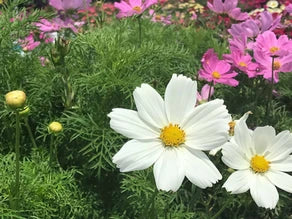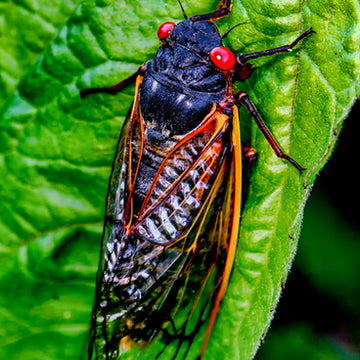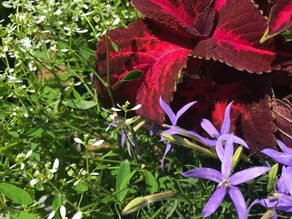Updated: Sep 14, 2022
Dry. Great if you are a classy Sauvignon Blanc. But if you are a backyard garden in the Midwest? Not so much.
Of course, we have work-arounds to keep your plants thriving in the summer months of little rain and high heat: mulch your beds and water, water, water. But at some point, even these proven strategies fail if the plants in your garden were meant for wetter, cooler climes. So the answer may be to rethink what you plant. Not only will you get better, prettier blooms but also a much-needed break from all that watering. No argument there, right?
THE ONE-TIME EVENT: BEST HEAT-TOLERANT ANNUALS FOR ST. LOUIS
If you are willing to spend time and money on installing annuals into your landscape, you want to get great value, right? We get it, and there are plenty of drought-resistant, low maintenance, long-blooming annuals out there to make the effort worth your while. Our top picks for beat-the-heat annuals include:
LANTANA
Known as a non-stop bloomer, lantana shrubs are loaded with flower clusters from spring to fall, even during a harsh, dry summer. With little extra care, they produce these mini bouquets in a rainbow of color from solid yellows, reds, oranges, blues and whites to fancy variegated varieties. Further, the leaves of lantana shrubs are poisonous to herbivores, so the deer will steer clear. Flowers, however, are a different story entirely and provide food for butterflies and birds. In fact, many wildlife enthusiasts use lantana as a main plant in their butterfly gardens. Everybody wins with lantana…ok, maybe not the deer.
SUNPATIENS
Perhaps you think we misspelled “impatiens,” but we haven’t. We’re talking about a revolutionary new hybrid that is quickly becoming a top favorite among home gardeners. Sunpatiens come in three varieties: you can plant compact-growing sunpatiens in containers, spreading sunpatiens that will overflow your window boxes and walled garden spaces or vigorous sunpatiens to fill up your flowerbed borders. No matter which you choose—and you could choose all three—you will have continuous, bold color from early spring to first frost. Sunpatiens aren’t afraid of a little (or a lot) of heat, strong sun or even a slight chill. They just keep blooming in a riot of color from pure white to sweet blush pink to regal purple to sexy scarlet red.
VINCA
Abundant blooms and easy care are the hallmarks of the vinca plant. As long as you have soil that drains well, you can grow vinca with very little fuss and muss. Some people think the thick flowers of the vinca plant look so perfect they aren’t real. But they are—very real, very beautiful and in it for the long haul. Vinca is a vining plant that grows in full sun to partial shade and will aid in controlling soil erosion, so consider planting it on small hills and slopes on your property. And while you will love the lush pink, white and purple flowers that last all summer until early frost, creatures such as deer could care less—and the less they care, the less they eat. Viva Vinca! Vinca foliage is also quite attractive, ranging from deep solid greens to variegated varieties, making every inch of garden interesting and pleasing.
COSMOS
The Cosmos—we’re talking about the Universe, right? Well, no. We are talking about an amazing family of annuals characterized by abundant, silky, daisy-like flowers, with natural pest resistance and super easy-care qualities. Cosmos is famous for surviving harsh dry conditions, even in fairly poor soil. So with just a little care, Cosmos thrives and blooms continually. Some deadheading will help keep everything picture perfect and extend the bloom season, but not much other care is needed. Since Cosmos grow to several heights and thicknesses, you can use them throughout your garden beds, tall ones as backdrops, bushy ones as fill-ins for
center spaces and short varieties for borders.
A LONGER LASTING SOLUTION: BEST HEAT-TOLERANT PERENNIALS FOR ST. LOUIS
If the idea of a beat-the-heat garden appeals to you, you may want to consider longer-term solutions. Of course, we are talking about perennials. Like the annuals above, the list of perennials below will help you maintain a beautiful garden, even if the summer weather turn hot, dry and ugly.
Agastache
Agastache is one of those ultra-forgiving plants that just keeps coming back every year for more abuse, although we are not recommending you purposefully abuse it, of course! The thing about Agastache, which is a member of the hyssop family of plants often used for herbal mixtures and teas, is that it is truly drought-loving—it actually grows better with low water—and doesn’t mind poor soil conditions. Unlike some of the plants we’ve discussed so far, Agastache has a unique spiral-shaped flower that affords an interesting shape of unlimited color with which to design. The blooms work very well in cut-flower arrangements, for instance. The Agastache flower is commonly found in purple to lavender but may also bloom in pink, rose, blue, white and orange. Agastache gives you a continuous color display and enduring greenery for months, despite a long, hot, dry summer. Bonus: the bees and other pollinators will thank you.
SALVIA
When we talk about Salvia—annual or perennial—we are actually talking about more than 90 species of plants, all related to the mint family. We can safely say that Salvia is one of the most popular of all the easy-care garden plants we offer. Often referred to as ornamental sages, Salvia comes in a variety of colors from white to pink to purple to nearly blue to red, and blooms appear in myriad shapes. They are so popular because they fill in garden spaces nicely with bushy, tall stems and long-lasting blooms and because they lead the “resistance,” against drought, deer and poor soil conditions. Salvia is always a safe and sound choice.
SEDUM
In contrast to plants such as Salvia or Cosmos, most varieties of Sedum grow closer to the ground—though some have longer stems—and resemble cactus and succulents. There are varieties that creep along your stone walls and around your patios. Some are suitable for contains and some look pretty keeping other plants company in patches of the garden—particularly along the borders. Sedum will grow just about anywhere—even through rocks. It requires almost no care but still offers you some astonishingly interesting greenery and flowers. Sedum is a favorite plant on rooftop gardens because of its ability to hold onto moisture, control soil erosion and defeat the heat of the summer sun. While it must have water eventually, it’s really the camel of the plant world. Because its appearance is distinct and sometimes down right unusual, sedum make a great plant for focal points in gardens.
HELIOPSIS
Named after the Greek sun god, Helios, and sometimes referred to as the “false sunflower,” Heliopsis has vibrant yellow flowers and is a native wildflower throughout a large portion of North America. As such, Heliopsis is “at home” in weather and soil conditions common to the Midwest. Drought, intense heat and less-than-perfect soil don’t phase it. Yet you’d never know it from its signature large masses of golden blooms, which can grow up to six feet high and four feet wide. Heliopsis is a perfect choice for sunny corners of your landscape that need a golden glow, which with a little deadheading should last mid-summer right into the fall.
So don’t let the summer heat get you down. Why not stop by our nursery and let us help you select your beat-the-heat best bets? There’s a wide variety—something just right for your little sunny hot spot.
 636-458-9202
636-458-9202


 Landscape Design & Installation
Landscape Design & Installation





